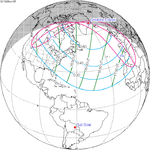Solar eclipse of November 10, 1920
Appearance
| Solar eclipse of November 10, 1920 | |
|---|---|
| Type of eclipse | |
| Nature | Partial |
| Gamma | 1.1287 |
| Magnitude | 0.742 |
| Maximum eclipse | |
| Coordinates | 69°54′N 29°48′W / 69.9°N 29.8°W |
| Times (UTC) | |
| Greatest eclipse | 15:52:15 |
| References | |
| Saros | 151 (9 of 72) |
| Catalog # (SE5000) | 9329 |
A partial solar eclipse occurred on November 10, 1920. A solar eclipse occurs when the Moon passes between Earth and the Sun, thereby totally or partly obscuring the image of the Sun for a viewer on Earth. A partial solar eclipse occurs in the polar regions of the Earth when the center of the Moon's shadow misses the Earth.
Related eclipses
Solar eclipses 1916–1920
This eclipse is a member of a semester series. An eclipse in a semester series of solar eclipses repeats approximately every 177 days and 4 hours (a semester) at alternating nodes of the Moon's orbit.[1]
The solar eclipses on February 3, 1916 (total), July 30, 1916 (annular), January 23, 1917 (partial), and July 19, 1917 (partial) occur in the previous lunar year eclipse set.
| Solar eclipse series sets from 1916 to 1920 | ||||||
|---|---|---|---|---|---|---|
| Ascending node | Descending node | |||||
| Saros | Map | Gamma | Saros | Map | Gamma | |
| 111 | December 24, 1916 Partial |
−1.5321 | 116 | June 19, 1917 Partial |
1.2857 | |
| 121 | December 14, 1917 Annular |
−0.9157 | 126 | June 8, 1918 Total |
0.4658 | |
| 131 | December 3, 1918 Annular |
−0.2387 | 136 Totality in Príncipe |
May 29, 1919 Total |
−0.2955 | |
| 141 | November 22, 1919 Annular |
0.4549 | 146 | May 18, 1920 Partial |
−1.0239 | |
| 151 | November 10, 1920 Partial |
1.1287 | ||||
Notes
- ^ van Gent, R.H. "Solar- and Lunar-Eclipse Predictions from Antiquity to the Present". A Catalogue of Eclipse Cycles. Utrecht University. Retrieved 6 October 2018.
References
- Earth visibility chart and eclipse statistics Eclipse Predictions by Fred Espenak, NASA/GSFC




